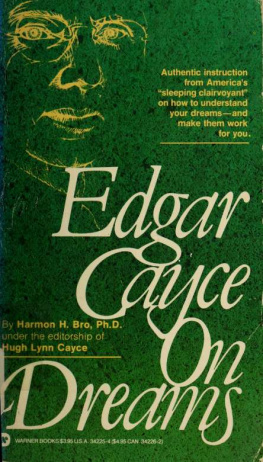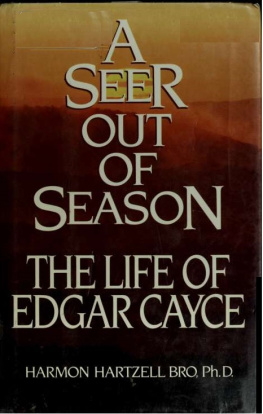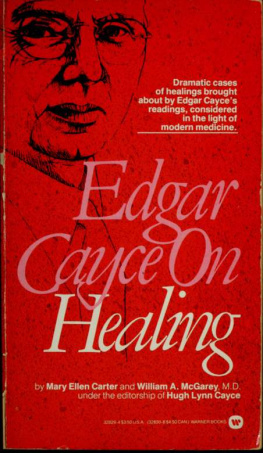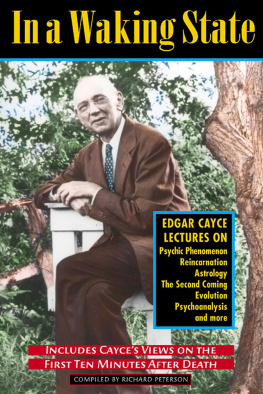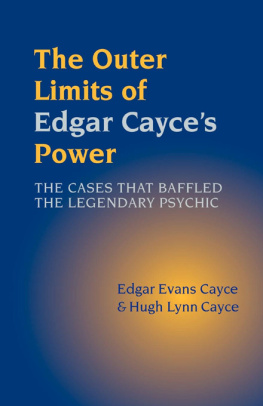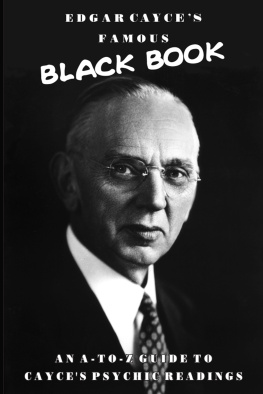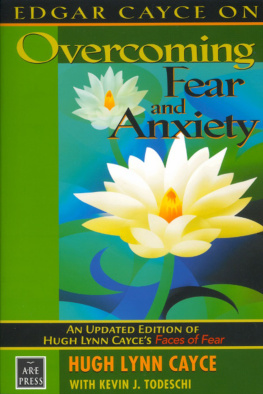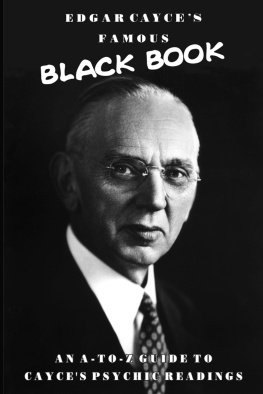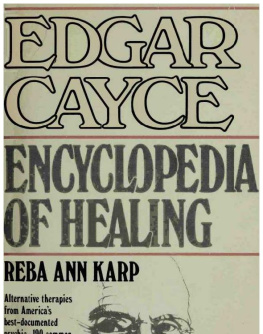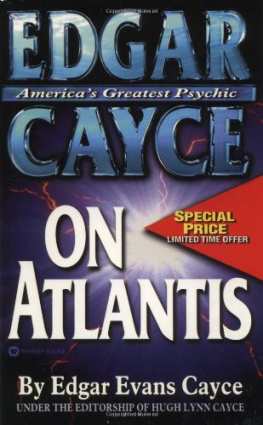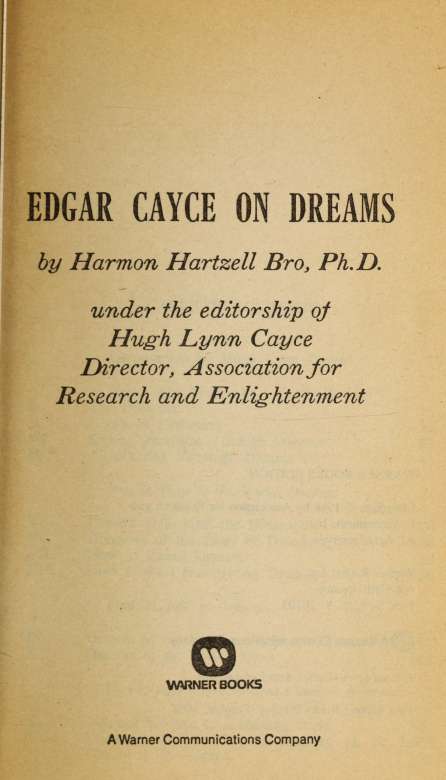Copyright 1968 by Association for Research and Enlightenment, Inc.
Warner Books, Inc.
666 Fifth Avenue New York. N Y 10103
Part I. The Dreams of a Young Woman
I. The Dreamer
II. Levels of Dreaming
III. Solving Problems Through Dreams
IV. Adventuring Through Dreams
Part II. How to Work with Dreams
V. Cayces Skilland the Dreamers
VI. Glimpses of the Laws of Dreaming
VII. How to Recall Dreams
VIII. How to Start Interpreting Dreams
Part III. ESP in Dreams
IX. Dreams of the Future and the Unknown Past
X. Dreams of the Living Dead
Part IV. Self-Development Through Dreams
XI. Through Dreams to a Healthy Body
XII. Orienting the Life Through Dreams
INTRODUCTION
WHO WAS EDGAR CAYCE?
The nine books which have been written about Edgar Cayce have totaled more than a million in sales. Many other books have devoted sections to his life and talents. He has been featured in dozens of magazines and hundreds of newspaper articles dating from 1900 to the present. What was so unique about him?
It depends on through whose eyes you look at him. A goodly number of his contemporaries knew the "waking" Edgar Cayce as a gifted professional photographer. Another group (predominantly children) admired him as a warm and friendly Sunday School teacher. His own family knew him as a wonderful husband and father.
The "sleeping" Edgar Cayce was an entirely different figurea psychic known to thousands of people, in all walks of life, who had cause to be grateful for his help. Indeed, many of them believed that he alone had either "saved" or "changed" their lives when all seemed lost. The "sleeping" Edgar Cayce was a medical diagnostician, a prophet, and a devoted proponent of Bible lore.
In June, 1954, the University of Chicago held him in sufficient respect to accept a Ph.D. thesis based on a study of his life and work. In this thesis the writer referred to him as a "religious seer." In that same year, the children's comic book House of Mystery bestowed on him the impressive title of "America's Most Mysterious Man!"
Even as a child, on a farm near Hopkinsville, Kentucky, where he was born on March 18, 1877, Edgar Cayce displayed powers of perception which seemed to extend beyond the normal range of the five senses. At the age of six or seven he told his parents that he was able to see and talk to "visions," sometimes of relatives who had recently died. His parents attributed this to the overactive imagination of a lonely child who had been influenced by the dramatic language of the revival meetings which were popular in that section of the country. Later, by sleeping with his head on his schoolbooks, he developed some form of photographic memory which helped him advance rapidly in the country school. This gift faded, however, and Edgar was only able to complete his seventh grade before he had to seek his own place in the world.
By the age of twenty-one he had become the salesman for a wholesale stationery company. At this time he developed a gradual paralysis of the throat muscles which threatened the loss of his voice. When doctors were unable to find a physical cause for this condition, hypnosis was tried, but failed to have any permanent effect. As a last resort, Edgar asked a friend to help him re-enter the same kind of hypnotic sleep that had enabled him to memorize his schoolbooks as a child. His friend gave him the necessary suggestion, and once he was in a self-induced trance, Edgar came to grips with his own problem. He recommended medication and manipulative therapy which successfully restored his voice and repaired his system.
A group of physicians from Hopkinsville and Bowling Green, Kentucky, took advantage of his unique talent to diagnose their own patients. They soon discovered that Cayce only needed to be given the name and address of a patient, wherever he was, to be able to tune in telepathically on that individual's mind and body as easily as if they were both in the same room. He needed, and was given, no other information regarding any patient.
One of the young M.D.'s, Dr. Wesley Ketchum, submitted a report on this unorthodox procedure to a clinical research society in Boston. On the ninth of October, 1910, The New York Times carried two pages of headlines and pictures. From that day on, troubled people from all over the country sought the "wonder man's" help.
When Edgar Cayce died on January 3, 1945, in Virginia Beach, Virginia, he left well over 14,000 documented stenographic records of the telepathic-clairvoyant statements he had given for more than six thousand different people over a period of forty-three years. These documents are referred to as "readings."
The readings constitute one of the largest and most impressive records of psychic perception ever to emanate from a single individual. Together with their relevant records, correspondence and reports, they have been cross^ indexed under thousands of subject headings and placed at the disposal of psychologists, students, writers and investigators who still come, in increasing numbers, to examine them.
A foundation known as the A.R.E. (Association for Research and Enlightenment, Inc., P. O. Box 595, Virginia Beach, Virginia, 23451) was founded in 1932 to preserve these Readings. As an open-membership research society, it continues to index and catalog the information, initiate investigation and experiments, and promote conferences, seminars and lectures. Until now, its published findings have been made available to its members through its own publishing facilities.
This is the fourth volume in a series of popular books dealing with those subjects from the Edgar Cayce readings.
This volume presents the data from more than six hundred Edgar Cayce Readings on dreams.
Harmon H. Bro, Ph.D., worked with Edgar Cayce for the better part of a yearfrom 1943 to 1944. He observed the regular schedule of daily readings. Coming to Virginia Beach as a skeptic he asked probing questions, interviewed persons who came for readings and read correspondence. Careful detailed notes became the basis for a doctoral thesis a few years later at the University of Chicago.
Recognizing as many students of the Readings have that Edgar Cayce placed unusual emphasis on the value of an individual's study of his own dreams, Dr. Bro has examined and thoroughly indexed the hundreds of dream readings.
Here is his first popular study of these readings. It is designed not only to present the challenging new concepts on dreams which are contained in this psychic's unusual approach to the subject, but also to enable the reader to apply these ideas in working with his own daily dream material.
In my opinion this is one of the best and most important studies ever made of the Edgar Cayce Readings.
Hugh Lynn Cayce
PART I. THE DREAMS OF A YOUNG WOMAN
CHAPTER I. THE DREAMER
She was young, just twenty-one. She was attractive, proud of her figure. She was ambitious, from a leading Mississippi family. She was bright, a graduate of a select women's college.
And now she was married. She had picked a Pennsylvania banker, eight years older, whom she had met at a family resort. She knew that his associates called his future promising, and she could imagine him on Wall Street someday.

